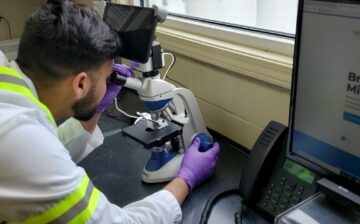
Safer Food, Better Health
Food safety is essential to fully benefit from food’s role in our lives. At Vitalus, our values of integrity, care, and expertise are at the core of our food safety practices.

Our body is inhabited by trillions of bacteria, fungi, and viruses which collectively live on and in our body as a community known as microbiota. Their genome is the microbiome. Under a microscope, the microbiome might appear as a bustling city. The concept of the human microbiome was first suggested by Joshua Lederberg, who coined the term “microbiome to signify the ecological community of commensal, symbiotic and pathogenic microorganisms that literally share our body space” [1,2]. Many research initiatives worldwide are working on mapping the human microbiome. One of these initiatives is the Human Microbiome Project (HMP), an initiative of the National Institutes of Health (NIH), which is a roadmap for Biomedical Research. It has been established by the scientific community that the human body is inhabited by at least 10 times more bacteria than the number of human cells in the body, the majority of which are found in the human gastrointestinal tract [2,3].
The gut microbiota plays many crucial functions in humans including helping ferment certain foods that the stomach and intestine cannot digest, contributing to the maintenance of other body functions [4]. Within gut microbiota, Bifidobacterium have received particular attention because of several important health functions attributed to them [5]. Several studies support the use of non-digestible ingredients or prebiotics as a mechanism to modulate the gut microbiota [6]. Many non-digestible carbohydrates have been reported to have such an effect. Galacto-oligosaccharides (GOS) and Fructo oligosaccharides (FOS) are the ones most extensively studied [7]. Non-digestible carbohydrates, by their definition, pass undigested through the upper gastrointestinal tract and act as a substrate for bacteria that colonize the large intestine thus contributing to their growth and activity.
Galacto-oligosaccharides (GOS) are non-digestible carbohydrates that are not hydrolyzed by endogenous enzymes and therefore pass through the human upper gastrointestinal tract to the distal small intestine and colon undigested [8]. The contribution of GOS to the growth of Bifidobacteria has been extensively studied in different age groups. Infants fed with infant formula supplemented with GOS have been shown to influence increased bifidobacterial levels as compared to those that received formula without GOS [9,10]. As well, the increase in the number of Bifidobacteria has been corroborated by many clinical trials conducted in adults [11,12,13,14]. Overall, the evidence suggests that GOS plays a role in supporting the gut microbiota.
To learn more about VITAGOS™, a GOS abundant, soluble prebiotic/fibre, click here
References:
[1] Lederberg, Joshua and Alexa T. McCray. “`Ome Sweet `Omics–A Genealogical Treasury of Words.” The Scientist 15 (2001): 8-8.
[2] NIH HMP Working Group et al. “The NIH Human Microbiome Project.” Genome research vol. 19,12 (2009): 2317-23. doi:10.1101/gr.096651.1
[3] Savage DC. Microbial ecology of the gastrointestinal tract. Annu Rev Microbiol. 1977;31:107–133
[4] Tojo, Rafael et al. “Intestinal microbiota in health and disease: role of bifidobacteria in gut homeostasis.” World journal of gastroenterology vol. 20,41 (2014): 15163-76. doi:10.3748/wjg.v20.i41.15163
[5] Rivière, Audrey et al. “Bifidobacteria and Butyrate-Producing Colon Bacteria: Importance and Strategies for Their Stimulation in the Human Gut.” Frontiers in microbiology vol. 7 979. 28 Jun. 2016, doi:10.3389/fmicb.2016.00979
[6] Scott, Karen P et al. “Manipulating the gut microbiota to maintain health and treat disease.” Microbial ecology in health and disease vol. 26 25877. 2 Feb. 2015, doi:10.3402/mehd.v26.2587
[7] Robert A. Rastall, Glenn R. Gibson, Recent developments in prebiotics to selectively impact beneficial microbes and promote intestinal health, Current Opinion in Biotechnology, Volume 32,2015, Pages 42-46, ISSN 0958-1669, https://doi.org/10.1016/j.copbio.2014.11.002.
[8] Van Loo J, Cummings J, Deizenne N, Englyst H, Franck A, Hopkins M, Kok N, MacFarlane G, Newton D, Quigley M, Roberfroid M, van Vliet T and van den Heuvel E, 1999. Functional food properties of non-digestible oligosaccharides: a consensus report from the ENDO Project (DGXII AIRII-CT94-1095). British Journal of Nutrition, 81, 121-132
[9] Sierra C, Bernal M-J, Blasco J, Martínez R, Dalmau J, et al. Prebiotic effect during the first year of life in healthy infants fed formula containing GOS as the only prebiotic: a multicenter, randomized, double-blind and placebo-controlled trial. Eur J Nutr 2015; 54(1): 89–99.
[10] Giovannini M, Verduci E, Gregori D, Ballali S, Soldi S, Ghisleni D, Riva E; PLAGOS Trial Study Group. Prebiotic effect of an infant formula supplemented with galacto-oligosaccharides: randomized multicenter trial. J Am Coll Nutr. 2014;33(5):385-93
[11] Canfora EE, van der Beek CM, Hermes GDA, Goossens GH, Jocken JWE, Holst JJ, et al. (2017). Supplementation of diet with galacto-oligosaccharides increases bifidobacteria, but not insulin sensitivity, in Obese prediabetic individuals. Gastroenterology 153(1):87-97.
[12] Vulevic J, Juric A, Tzortzis G, Gibson GR (2013). A mixture of trans-galactooligosaccharides reduces markers of metabolic syndrome and modulates the fecal microbiota and immune function of overweight adults. J Nutr 143(3):324-331.
[13] Ladirat SE, Schoterman MHC, Rahaoui H, Mars M, Schuren FHJ, Gruppen H, et al. (2014). Exploring the effects of galacto-oligosaccharides on the gut microbiota of healthy adults receiving amoxicillin treatment. Br J Nutr 112(4):536-546
[14] Vulevic J, Juric A, Walton GE, Claus SP, Tzortzis G, Toward RE, et al. (2015). Influence of galacto-oligosaccharide mixture (B-GOS) on gut microbiota, immune parameters and metabonomics in elderly persons. Br J Nutr 114(4):586-59